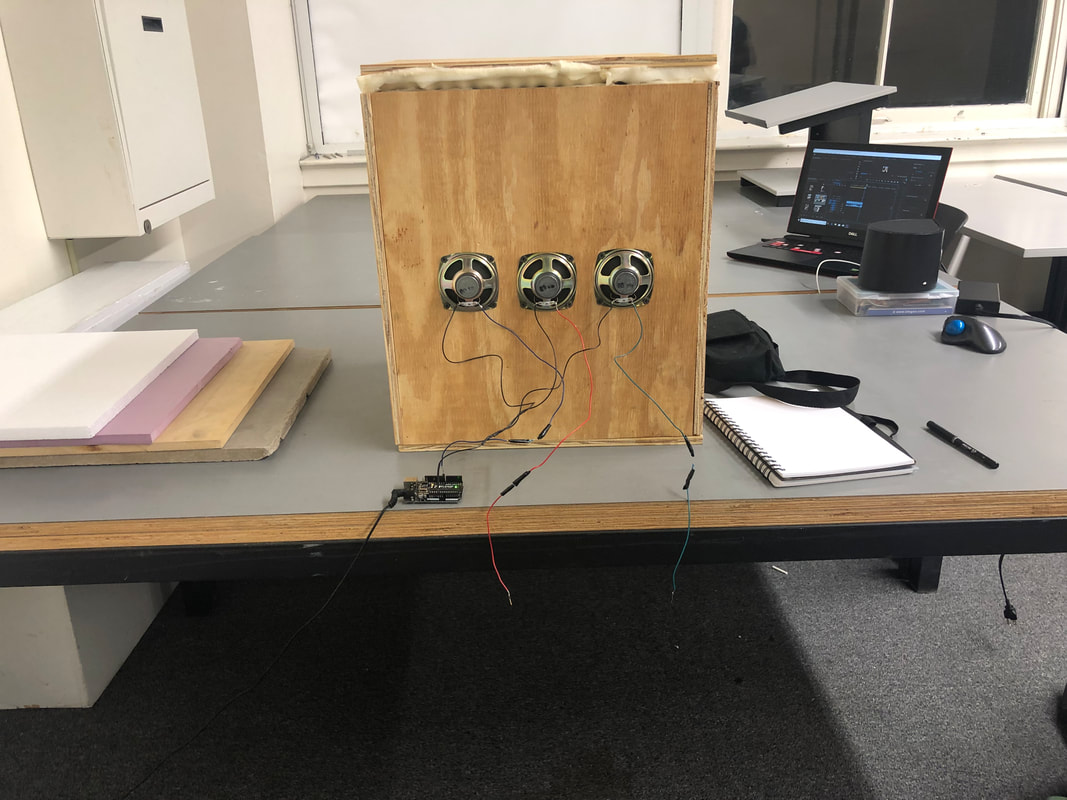ARDUINO CODEWHEN GATHERING THE RESISTORS FOR PROJECT MAKE SURE TO NOT MAKE THE MISTAKE AND GRAB 100K RESISTORS! THE CODE RECCOMENDS 100 ohms. WHEN LOOK FOR 100 ohms, SELECT THE RESISTORS WITH JUST THE NUMBER "100" WRITTEN ON THEM.
MOCK-UP / TESTING CODETHE CODE WAS FIRST TESTED WITH BUZZERS TO MAKE SURE THE CODE WAS WORKING. FOR FINAL CONSTRUCTION THE SPEAKERS WILL BE ADDED.
FINAL CODE AND CONSTRUCTION |
Overview of the Experiment/Design
The sound box will test different building materials for sound absorbency. Without building a sound proofing wall, this experiment will be able to test what material on its own will be able to absorb noise at different decibels. The results will be measured by using a 5-N-1 reader to be able to record the changes in air pressure caused by sound waves which will then be converted into an electrical signal, and displaying the resulting sound pressures read in decibels. The different frequencies that will be tested through the speakers are 20 Hz to 16kHz over a three minute period. Population/Sample By using the inner testing chamber the 5-N-1 will be able to assess the noise of sound level coming from the tested material. SAMPLES THAT CAN BE TESTED Any building material that can be cut down to fit inside the testing slot Material examples: Concrete Insulation Foam Styrofoam MDF (Medium Density Fiberboard) Cardboard Location The sound box should be placed in an area that is relatively quiet so the 5-N-1 can accurately test the noise levels moving through the testing material. Restrictions/Limiting Conditions Sound travels like air and this can cause for some of the test results to read inaccurately. Testing each side of the box to make sure it is sound proof is a pertinent part of the experiment. Sampling Technique / Procedures Step 1 : Figure out what material you want to test and cut it down to fit inside the book. Make sure your material fits inside tightly. Step 2: Build a box with a detachable lid that is composed of squares that are 2’ by 2’ (YOU WANT THIS TO PORTABLE AND EASY TO ACCESS DO NOT MAKE SMALLER THAN 1’ by 1’) Step 3: Use inner chamber to add testing material Step 4: Turn on speaker and 5-N-1 Step 5: RECORD FOR THREE MINUTES OR WHEN 5-N-1 IS CONSTANT. Materials to Build Testing Box MDF OR PLYWOOD 5-N-1 ARDUINO STARTER KIT ARDUINO SPEAKERS SOUND PROOFING FOAM OR BED FOAM TOPPER WOOD SHOP EQUIPMENT ANY TESTING MATERIAL LISTED ABOVE Variables The decibels Amount of Sound getting inside of testing chamber Size of samples Average thickness of testing materials Amount of noise in the room where testing chamber is located Statistical Treatment Use excel graphs to record data and compare test results from one material to another. |
